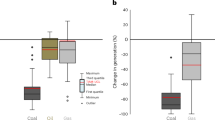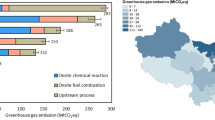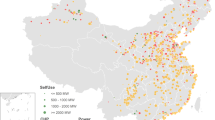Abstract
To keep global warming within 1.5 °C of pre-industrial levels, there needs to be a substantial decline in the use of coal power by 20301,2 and in most scenarios, complete cessation by 20501,3. The members of the Powering Past Coal Alliance (PPCA), launched in 2017 at the UNFCCC Conference of the Parties, are committed to “phasing out existing unabated coal power generation and a moratorium on new coal power generation without operational carbon capture and storage”4. The alliance has been hailed as a ‘political watershed’5 and a new ‘anti-fossil fuel norm’6. Here we estimate that the premature retirement of power plants pledged by PPCA members would cut emissions by 1.6 GtCO2, which is 150 times less than globally committed emissions from existing coal power plants. We also investigated the prospect of major coal consumers joining the PPCA by systematically comparing members to non-members. PPCA members extract and use less coal and have older power plants, but this alone does not fully explain their pledges to phase out coal power. The members of the alliance are also wealthier and have more transparent and independent governments. Thus, what sets them aside from major coal consumers, such as China and India, are both lower costs of coal phase-out and a higher capacity to bear these costs.
This is a preview of subscription content, access via your institution
Access options
Access Nature and 54 other Nature Portfolio journals
Get Nature+, our best-value online-access subscription
$29.99 / 30 days
cancel any time
Subscribe to this journal
Receive 12 print issues and online access
$209.00 per year
only $17.42 per issue
Buy this article
- Purchase on Springer Link
- Instant access to full article PDF
Prices may be subject to local taxes which are calculated during checkout



Similar content being viewed by others
Data availability
The data file for regression analysis is available in the Supplementary Information. Data for the figures are available from the corresponding author upon request.
References
Rocha, M. et al. Implications of the Paris Agreement for Coal Use in the Power Sector (Climate Analytics, 2016).
Luderer, G. et al. Residual fossil CO2 emissions in 1.5–2 °C pathways. Nat. Clim. Change 8, 626–633 (2018).
IPCC: Summary for Policymakers. In Global Warming of 1.5°C (eds Masson-Delmotte, M. et al.) (World Meteorological Organization, 2018).
Powering Past Coal Alliance: declaration and member list. Government of Canada https://www.canada.ca/en/services/environment/weather/climatechange/canada-international-action/coal-phase-out/alliance-declaration.html (2018).
Carrington, D. ‘Political watershed’ as 19 countries pledge to phase out coal. The Guardian (16 November 2017).
Green, F. Anti-fossil fuel norms. Climatic Change 150, 103–116 (2018).
All of the UK’ s remaining coal plants will shut down by 2025. Climate Action http://www.climateaction.org/news/all-of-the-uks-remaining-coal-plants-will-shut-down-by-2025 (2018).
Littlecott, C., Burrows, L. & Skillings, S. Summary—insights from the UK coal phase out experience. E3G https://www.e3g.org/library/summary-insights-from-the-uk-coal-phase-out-experience (2018).
Brittlebank, W. France to end coal production by 2023. Climate Action http://www.climateactionprogramme.org/news/france_to_end_coal_production_by_2023 (2016).
The Government Wants to Eliminate Coal Production Before 2030 (Government of Portugal, 2016).
Gates, S. Finland plans to phase out coal use in energy production by 2025. Huffington Post (10 February 2016).
Wynn, G. The Dutch Coal Mistake: How Three Brand-New Power Plants in the Netherlands are at Risk Already of Becoming Stranded Assets (IEEFA, 2016).
Johnson, N. et al. Stranded on a low-carbon planet: implications of climate policy for the phase-out of coal-based power plants. Technol. Forecast. Soc. Change 90, 89–102 (2015).
Edenhofer, O., Steckel, J. C., Jakob, M. & Bertram, C. Reports of coal’s terminal decline may be exaggerated. Environ. Res. Lett. 13, 24019 (2018).
David, S. J. & Socolow, R. H. Commitment accounting of CO2 emissions. Environ. Res. Lett. 9, 084018 (2014).
Huppman, D. et al. IAMC 1.5 °C Scenario Explorer and Data Hosted by IIASA release 1.0 (International Institute for Applied Systems Analysis & Integrated Assessment Modeling Consortium, 2018); https://doi.org/10.22022/SR15/08-2018.15429
Rogelj, J. et al. in Global Warming of 1.5 °C (eds Masson-Delmotte, V. et al.) Ch. 2 (IPCC, 2018).
Spencer, T. et al. The 1.5 °C target and coal sector transition: at the limits of societal feasibility. Clim. Policy 18, 335–351 (2018).
Helm, D. Energy policy: security of supply, sustainability and competition. Energy Policy 30, 173–184 (2002).
Freedom in the World 2018: Methodology (Freedom House, 2018).
Neslen, A. Spain to close most coalmines in €250m transition deal. The Guardian (26 October 2018).
Draft of the Integrated National Energy and Climate Plan 2021–2030 (Ministry of Ecological Transition for the Government of Spain, 2018).
World Energy Balances (International Energy Agency, 2018); https://www.iea.org/statistics/balances/
World Electric Power Plants Data Base (S&P Global Platts, 2017).
Kommission ‘Wachstum, Strukturwandel und Beschäftigung’ (Federal Ministry for the Environment, Nature Conservation and Nuclear Safety, 2019).
Darby, M. Germany ready to join global coal phase-out alliance: environment minister. Climate Home News (15 March 2019).
Viele Milliarden für den Kohleausstieg. Zeit Online https://www.zeit.de/wirtschaft/2019-01/kohlekommission-kohleausstieg-bundesregierung-plan-kraftwerke-braunkohle (2019).
Wehrmann, B. RWE substantiates claims for billion-euro coal plant compensation. Clean Energy Wire (15 March 2019).
Cembalest, M. Eye on the Market: Annual Energy Paper (J. P. Morgan, 2019).
Schultz, S. Deutschland soll bis spätestens 2038 aus der Kohle aussteigen. Spiegel Online https://www.spiegel.de/wirtschaft/soziales/deutschland-soll-bis-spaetestens-2038-aus-der-kohle-aussteigen-a-1250104.html (2019).
Schultz, S. Was die Einigung zum Kohleausstieg bringt. Spiegel Online https://www.spiegel.de/wirtschaft/soziales/analyse-zum-kohleausstieg-damit-ist-das-deutsche-klimaziel-zu-schaffen-a-1250097.html (2019).
Normile, D. Bucking global trends, Japan again embraces coal power. Science 360, 476–477 (2018).
Cherp, A. & Jewell, J. Energy policy: renewables targeted before Fukushima. Nature 533, 36 (2016).
Toda, M. & Kawamura, T. Japan to rule out coal-fired plants as international criticism rises. The Asahi Shimbun (28 March 2019).
Karp, P. Australian government backs coal in defiance of IPCC climate warning. The Guardian (8 October 2018).
Remarks by President Trump at the Unleashing American Energy Event (The White House, 2017); https://www.whitehouse.gov/briefings-statements/remarks-president-trump-unleashing-american-energy-event/
Shearer, C., Yu, A. & Nace, T. Tsunami Warning: Can China’s Central Authorities Stop a Massive Surge in New Coal Plants Caused by Provincial Overpermitting? (End Coal, 2018).
Xu, M. & Stanway, D. China to Cut Coal Use, Curb Steel in 2018-2020 Pollution Plan (Reuters, 2018).
China’s First INDC Submission (Department of Climate Change and National Development & Reform Commision of China, UNFCCC, 2015).
Keohane, R. O. & Victor, D. G. Cooperation and discord in global climate policy. Nat. Clim. Change 6, 570–575 (2016).
Victor, D. G. Global Warming Gridlock: Creating More Effective Strategies for Protecting the Planet (Cambridge Univ. Press, 2011).
Hovi, J., Sprinz, D. F., Sælen, H. & Underdal, A. Climate change mitigation: a role for climate clubs? Palgrave Commun. 2, 16020 (2016).
Reitzenstein, A. & Popp, R. A role model for European coal phase out? Five lessons from the German Coal Commission. E3G https://www.e3g.org/library/a-role-model-for-european-coal-phase-out-five-lessons-from-the-german-coal (2019).
Gray, M., Ljungwaldh, S., Watson, L. & Kok, I. Powering Down Coal: Navigating the Economic and Financial Risks in the Last Years of Coal Power (Carbon Tracker, 2018).
Gimon, E., O’Boyle, M., Clack, C. T. M. & McKee, S. The Coal Cost of Crossover: Economic Viability of Existing Coal Compared to New Local Wind and Solar Resources (Energy Innovation and Vibrant Clean Energy, 2019).
Master Plan for Siting Electricity Facilities up to 2035 Decree 1209 (The Government of the Russian Federation, 2017).
Energy Strategy of Russia for the Period to 2035 (The Government of the Russian Federation, 2017).
National Plan for Reduction of Emissions from Large Combustion Facilities (The Government of Ukraine, 2017).
Overview: National Coal Phase-Out Announcements in Europe (Beyond Coal, 2018).
Europe Coal Phase Outs Gather Pace (Economist Intelligence Unit, 2017).
Coal Phase-Out: the Powering Past Coal Alliance (Government of Canada, 2018); https://www.canada.ca/en/services/environment/weather/climatechange/canada-international-action/coal-phase-out.html
ABC News. NZ signs up to phase out coal power by 2030. Radio New Zealand (18 November 2017).
Energy Economy Objectives for the Year 2030 (State of Israel Ministry of Energy, 2018); http://www.energy-sea.gov.il/English-Site/Pages/Regulation/energy_economy_objectives_2030.pdf
Rionda, R. A. et al. (eds) Prospectiva del Sector Eléctrico 2017–2031 (Secretaría de Energía, 2017).
Paulos, B. Washington State leaves coal behind, but not its workers. Energy Transition (4 January 2018).
Global Coal Plant Tracker (Coal Swarm, accessed 20 April 2018); https://endcoal.org/tracker/
Climate Leadership Plan: Phasing out coal pollution (Government of Alberta, 2018).
Beetz, B. Spain’s Balearic Islands proposes ambitious 100% renewable energy law. PV Magazine (15 February 2018).
Chen, H. Korean Province to phase out coal: implications for Asia. National Resource Defense Council (2 October 2018); https://www.nrdc.org/experts/han-chen/korean-province-phase-out-coal-implications-asia
Scottish Government joins clean power group (Scottish Government, 2018); https://www.gov.scot/news/powering-past-coal-alliance/
New York moves to end coal-fired power plants by 2020. KallanishEnergy http://www.kallanishenergy.com/2018/05/21/new-york-moves-to-end-coal-fired-power-plants-by-2020/ (2018).
Henry, D. NY gov aims to phase out coal by. The Hill (13 January 2016).
Opalka, B. New England’s last coal-fired power plants face uncertain futures. Energy News (16 August 2018).
Yerton, S. Oahu’s cheapest source of power is about to go away. Honolulu Civil Beat (24 August 2017).
Orr, I. Minnesota plans to retire 1,829 MW of coal and replace it with 7,200 MW of wind, solar, and gas. American Experiment (10 July 2018).
78th Oregon Legislative Assembly (United States Government, 2016).
World Bank Open Data (World Bank, 2018); https://data.worldbank.org/
NDC Registry (UNFCCC, 2019); https://www4.unfccc.int/sites/ndcstaging/Pages/Home.aspx
National Communication Submissions from Non-Annex I Parties (UNFCCC, 2019); https://unfccc.int/process-and-meetings/transparency-and-reporting/reporting-and-review-under-the-convention/national-communications-and-biennial-update-reports-non-annex-i-parties/national-communication-submissions-from-non-annex-i-parties
National energy and climate plans. European Commission https://ec.europa.eu/energy/en/topics/energy-strategy-and-energy-union/governance-energy-union/national-energy-climate-plans (2019).
Katzer, J. et al. The Future of Coal: An Interdisciplinary MIT Study (Massachusetts Institute of Technology, 2007).
Hardisty, P. E. et al. Life cycle greenhouse gas emissions from electricity generation: a comparative analysis of Australian energy sources. Energies 5, 872–897 (2012).
Carbon Dioxide Emission Coefficients (US Energy Information Administration, 2016); https://www.eia.gov/environment/emissions/co2_vol_mass.php
Average Operating Heat Rate for Selected Energy Sources (EIA, 2018); https://www.eia.gov/electricity/annual/html/epa_08_01.html
Cleves, M., Gould, W. W., Gutierrez, R. & Marchenko, Y. An Introduction to Survival Analysis using Stata (Stata Press, 2010).
Myers, R. H. Classical and Modern Regression with Applications (Duxbury Thomas Learning, 1990).
Kleinbaum, D. G. & Klein, M. Logistic Regression: A Self-learning Text (Springer, 2010).
Acknowledgements
This work was supported by the Research Council Norway under the Analyzing past and future energy industry contractions: Towards a better understanding of the flip-side of energy transitions Project under grant agreement no. 267528/E10. A.C. received support from the Central European University’s Intellectual Themes Initiative Political Economy of Energy Transitions Project.
Author information
Authors and Affiliations
Contributions
J.J. conceived the study. J.J., A.C. and V.V. designed the research. J.J., V.V. and L.N. carried out the research. All authors analysed the results. J.J., A.C. and V.V. wrote the paper.
Corresponding author
Ethics declarations
Competing interests
The authors declare no competing interests.
Additional information
Peer review information: Nature Climate Change thanks Pao-Yu Oei, I. A. Grant Wilson and the other, anonymous, reviewer(s) for their contribution to the peer review of this work.
Publisher’s note: Springer Nature remains neutral with regard to jurisdictional claims in published maps and institutional affiliations.
Supplementary information
Supplementary Data 1
Replication dataset for logistic regression
Supplementary Data 2
Replication script for logistic regression
Rights and permissions
About this article
Cite this article
Jewell, J., Vinichenko, V., Nacke, L. et al. Prospects for powering past coal. Nat. Clim. Chang. 9, 592–597 (2019). https://doi.org/10.1038/s41558-019-0509-6
Received:
Accepted:
Published:
Issue Date:
DOI: https://doi.org/10.1038/s41558-019-0509-6
This article is cited by
-
Understanding supply-side climate policies: towards an interdisciplinary framework
International Environmental Agreements: Politics, Law and Economics (2024)
-
Perceived feasibility and potential barriers of a net-zero system transition among Japanese experts
Communications Earth & Environment (2023)
-
Co-firing plants with retrofitted carbon capture and storage for power-sector emissions mitigation
Nature Climate Change (2023)
-
Socio-political feasibility of coal power phase-out and its role in mitigation pathways
Nature Climate Change (2023)
-
Coal-exit alliance must confront freeriding sectors to propel Paris-aligned momentum
Nature Climate Change (2023)



